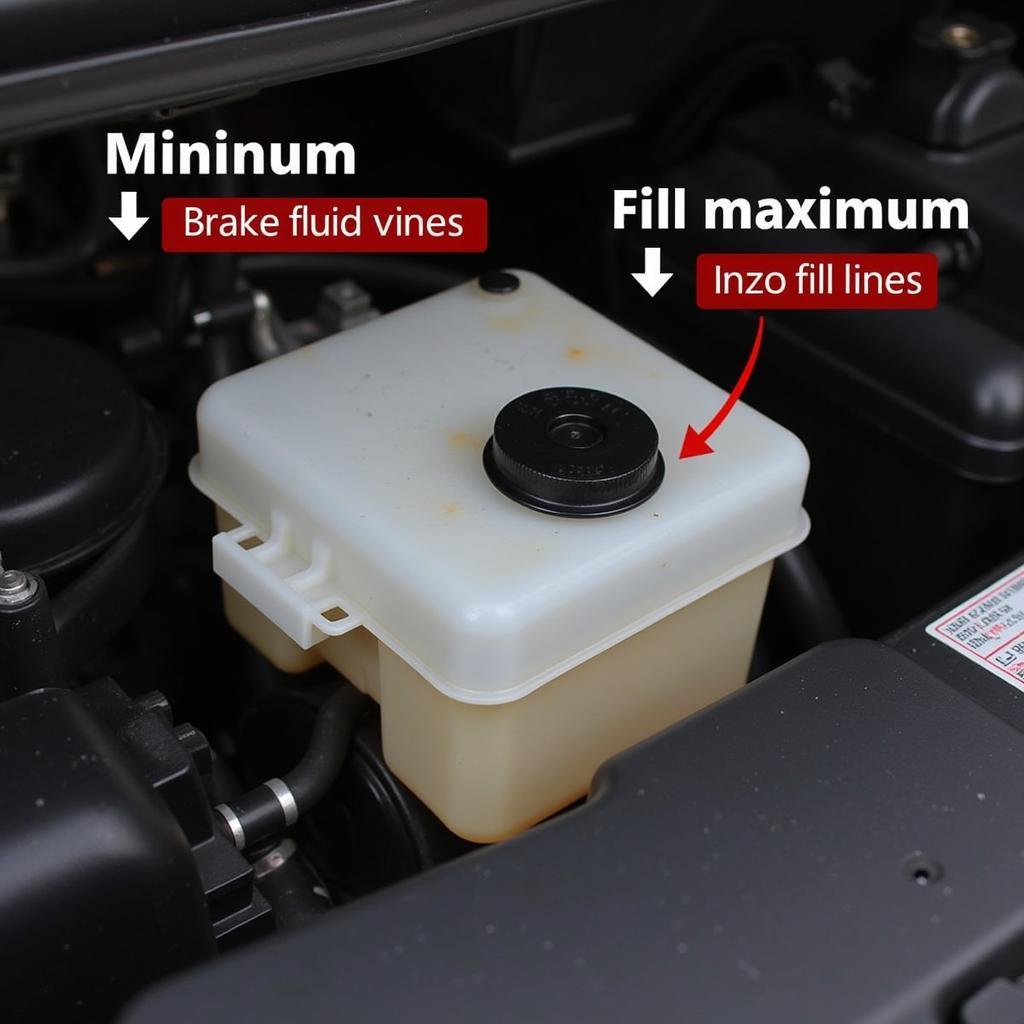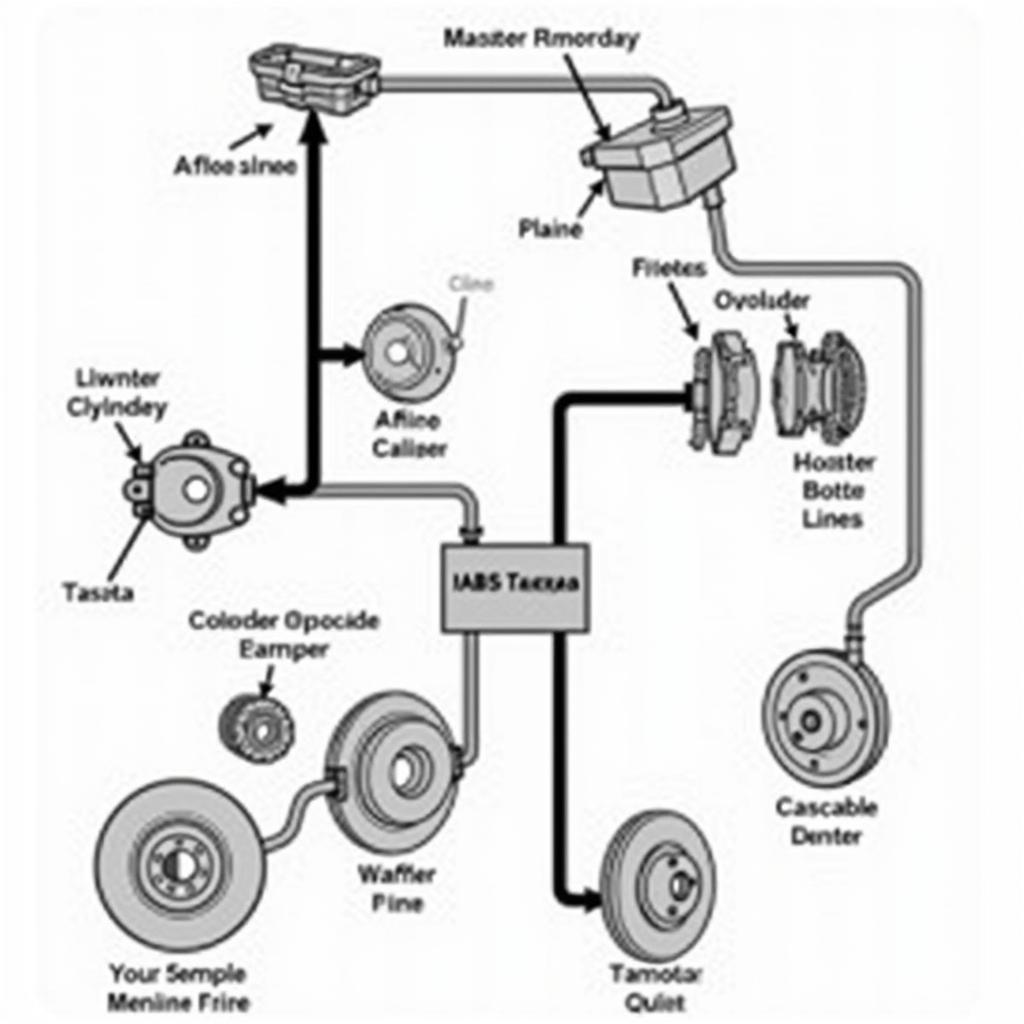The brake warning light on your Toyota Tacoma dashboard is a crucial safety feature. When it illuminates, it signals a potential issue within your braking system that requires immediate attention. Ignoring this warning can compromise your ability to stop safely, putting you and others at risk. This comprehensive guide delves into the common causes of a brake warning light in Toyota Tacoma trucks, potential solutions, and steps for diagnosis and repair.
Common Causes of a Brake Warning Light
Understanding why your Toyota Tacoma’s brake warning light is on is the first step toward resolution. Here are the most frequent culprits:
- Low Brake Fluid: This is the most common reason for the warning light. A leak in the brake lines or worn brake pads can lead to low fluid levels.
- Worn Brake Pads: Your Tacoma is equipped with sensors that trigger the warning light when the brake pads wear thin, signaling the need for replacement.
- Faulty Brake Light Switch: This switch, located beneath the brake pedal, signals the brake lights to activate when you press the pedal. A malfunction can confuse the system and illuminate the warning light.
- ABS Issue: If there’s a problem with your Anti-lock Braking System (ABS), like a faulty sensor, the brake warning light might illuminate alongside the ABS warning light.
- Master Cylinder Malfunction: The master cylinder is the heart of your braking system, responsible for distributing brake fluid. If it fails, you’ll experience braking problems and likely see the warning light.
 Toyota Tacoma Brake Fluid Reservoir
Toyota Tacoma Brake Fluid Reservoir
What to Do When Your Brake Warning Light Turns On
If your brake warning light comes on, prioritize safety with these steps:
- Safely Pull Over: Find a safe location to pull over immediately.
- Check Brake Fluid: With the engine off, carefully open the hood and locate the brake fluid reservoir. Check the fluid level. If it’s low, adding brake fluid might temporarily resolve the issue, but a professional inspection is crucial to identify and address the underlying cause of the leak.
- Inspect Brake Pedal: Does the brake pedal feel spongy or go further down than usual? This could indicate air in the brake lines or another serious issue.
- Listen for Unusual Noises: When applying the brakes, pay attention to any unusual noises like grinding or squealing, which can indicate worn brake pads.
- Avoid Driving: If you notice any abnormalities or suspect a serious problem, avoid driving and have your vehicle towed to a trusted mechanic or dealership for diagnosis and repair.
 Inspecting Toyota Tacoma Brake Pads
Inspecting Toyota Tacoma Brake Pads
Diagnosing and Fixing the Problem
Accurately diagnosing the root cause of the brake warning light often requires specialized equipment and expertise. Here’s a glimpse into the diagnostic process:
- Visual Inspection: A mechanic will begin by visually inspecting the brake system components, including the pads, rotors, calipers, brake lines, hoses, and the master cylinder, for signs of wear, leaks, or damage.
- Brake Fluid Testing: The mechanic may test the brake fluid for contamination, which can affect braking performance.
- Electronic Diagnosis: Modern vehicles like the Toyota Tacoma have sophisticated onboard computer systems. A mechanic can use a diagnostic scanner to read trouble codes stored in the vehicle’s computer, which can pinpoint specific issues with the ABS or other electronic components within the brake system.
- Brake Pad/Rotor Replacement: Worn brake pads and rotors are a common issue and will be replaced as needed.
- Brake Fluid Flush and Refill: If the brake fluid is low or contaminated, a complete flush and refill with the recommended brake fluid type are necessary.
- Repair or Replacement of Faulty Components: Depending on the diagnosis, faulty parts such as the master cylinder, brake calipers, wheel cylinders, brake lines, hoses, or ABS sensors may require repair or replacement.
Preventing Future Brake Warning Light Issues
Proactive maintenance is key to preventing future brake problems:
- Regular Brake Inspections: Schedule routine brake inspections, ideally every 12,000 miles or as recommended in your Toyota Tacoma’s owner’s manual.
- Timely Brake Pad Replacement: Don’t wait for the warning light to replace worn brake pads. Replace them preemptively based on your driving habits and wear patterns.
- Quality Brake Parts: When replacing brake components, always opt for high-quality parts from reputable manufacturers to ensure optimal performance and longevity.
- Be Mindful of Driving Habits: Aggressive driving with hard braking can accelerate wear and tear on your brakes. Adopt smoother driving habits for improved brake longevity.
 Toyota Tacoma Brake System Diagram
Toyota Tacoma Brake System Diagram
FAQs about Toyota Tacoma Brake Warning Light
Q: Can I drive my Toyota Tacoma with the brake warning light on?
A: It’s highly discouraged to drive with the brake warning light on. It signals a potential issue that could affect your ability to brake safely. Seek immediate inspection and repair.
Q: How much does it cost to fix a brake warning light on a Toyota Tacoma?
A: The repair cost varies greatly depending on the underlying cause. A simple brake pad replacement is far less expensive than a master cylinder replacement. Get a quote from a trusted mechanic for an accurate estimate.
Q: How often should I check my Toyota Tacoma’s brake fluid?
A: It’s a good practice to check your brake fluid level at least once a month and top it off if necessary.
Q: Can I add any type of brake fluid to my Toyota Tacoma?
A: No, using the incorrect type of brake fluid can damage your brake system. Consult your owner’s manual for the recommended brake fluid type for your Toyota Tacoma model year.
Q: How can I prevent my Toyota Tacoma’s brake warning light from coming on?
A: Adhering to a regular maintenance schedule, including brake inspections and timely replacement of worn components, can help prevent future brake warning light issues.
Don’t Ignore the Warning
Your Toyota Tacoma’s brake warning light is a critical safety feature, not a suggestion. Addressing the underlying issue promptly can prevent more costly repairs down the line and, most importantly, keep you safe on the road. If you’re experiencing brake problems or have any concerns, consult a qualified mechanic for diagnosis and repair.
Remember, when it comes to your safety and the safety of others on the road, prompt attention to your vehicle’s brake system is paramount.

